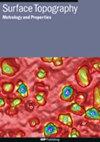硅晶片氩等离子体预处理对Mo/Au夹层Si-Si键合的影响
IF 2
3区 材料科学
Q2 ENGINEERING, MECHANICAL
引用次数: 0
摘要
为提高室温下Mo/Au中间层硅硅片的键合质量,对硅片表面进行了氩等离子体预处理,并通过实验和理论相结合的方法分析了氩等离子体预处理对硅硅片键合的影响。经过等离子体处理后,硅晶片表面粗糙度明显降低,结合后的硅-硅样品具有较低的界面空隙。经氩等离子体预处理的Si-Si结合样品的平均结合强度为11.46 MPa,远高于未经预处理的Si-Si结合样品的4.23 MPa。断裂面分析表明,未氩等离子体处理的Si-Si结合试样的断裂主要发生在Mo/Si界面,而等离子体处理的Si-Si结合试样的断裂主要发生在体Si内部。分子动力学(MD)模拟表明,Mo/Au界面发生了强烈的原子扩散,而Mo原子几乎没有扩散到体Si中。结果表明,氩等离子体预处理不仅能使硅片表面清洁活化,还能使硅片表面光滑,有利于提高沉积Mo/Au膜的质量,提高Mo膜与硅片的附着力。本文章由计算机程序翻译,如有差异,请以英文原文为准。
Effects of argon plasma pretreatment of Si wafers on Si-Si bonding based on Mo/Au interlayers
To improve the bonding quality of Si-Si wafers bonded based on Mo/Au intermediate layers at room temperature, the surfaces of Si wafers were pretreated with argon plasma, and the effect of argon plasma pretreatment on Si-Si wafer bonding was analyzed by combining experimental and theoretical methods. Owing to the plasma treatment of Si wafers, the surface roughness of Si wafers was significantly reduced, and the bonded Si-Si samples had lower interfacial voidage. The average bonding strength of 11.46 MPa for the argon plasma pretreated Si-Si bonded samples is much higher than the bonding strength of 4.23 MPa for the unpretreated Si-Si bonded samples. The analysis of the fractured surface revealed that the fracture of the Si-Si bonded samples without argon plasma treatment occurred mainly at the Mo/Si interface, while the fracture of the plasma-treated Si-Si bonded samples arose mainly within the bulk Si. Molecular dynamics (MD) simulations suggest that strong atomic diffusion takes place at the Mo/Au interface, while Mo atoms hardly diffuse into the bulk Si. These results indicate that argon plasma pretreatment not only cleans and activates the Si wafer surface but also makes the Si wafer surface smooth, which helps to enhance the deposited Mo/Au film quality and the adhesion between the Mo film and the Si wafer.
求助全文
通过发布文献求助,成功后即可免费获取论文全文。
去求助
来源期刊

Surface Topography: Metrology and Properties
Materials Science-Materials Chemistry
CiteScore
4.10
自引率
22.20%
发文量
183
期刊介绍:
An international forum for academics, industrialists and engineers to publish the latest research in surface topography measurement and characterisation, instrumentation development and the properties of surfaces.
 求助内容:
求助内容: 应助结果提醒方式:
应助结果提醒方式:


